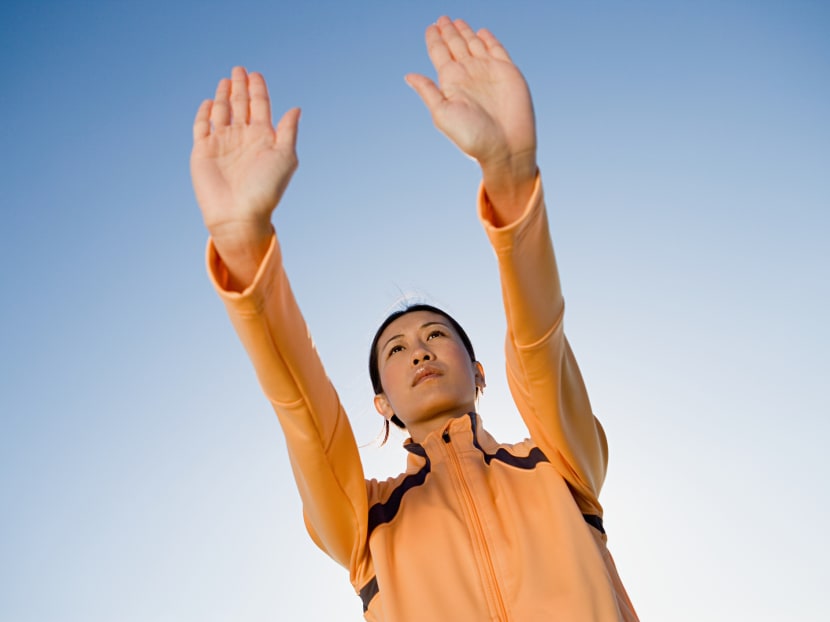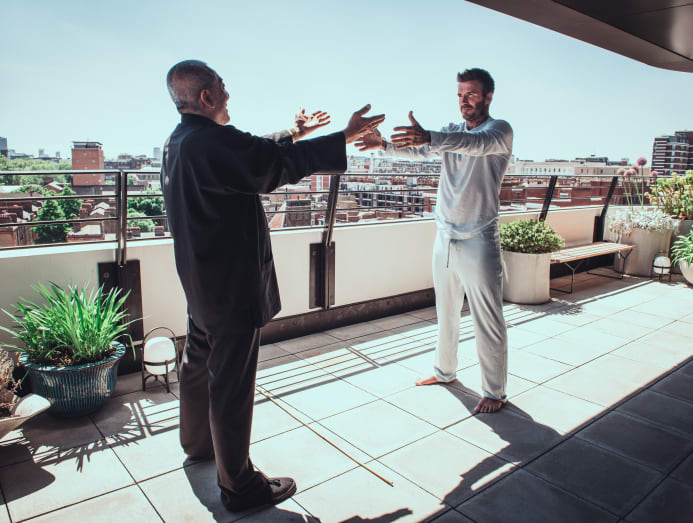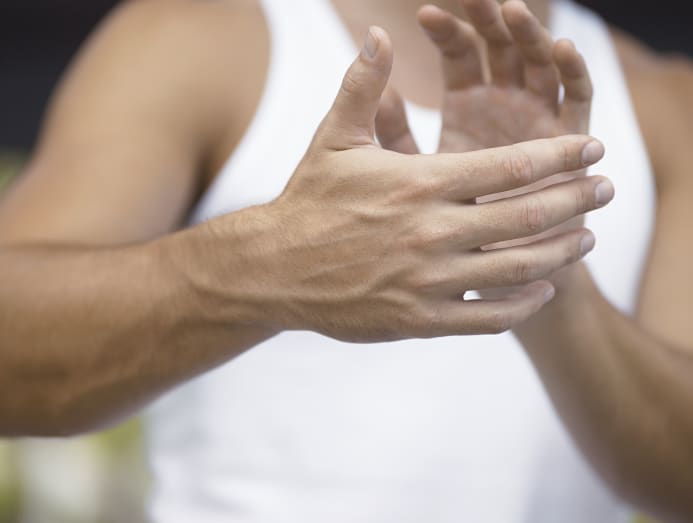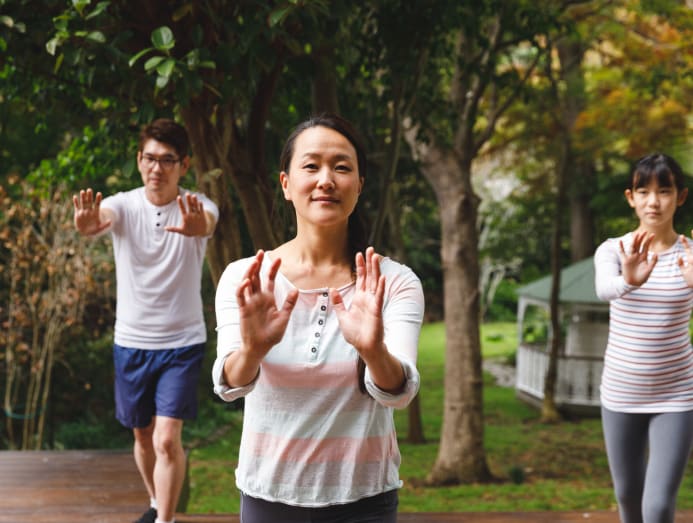How did qigong suddenly become a cool workout for young people?
Yes, it's no longer just for seniors or confined to Chinese clans and wushu associations. The supposedly old-fashioned practice is now embraced by those in their 30s and 20s (even David Beckham gave it a go).

(Photo: iStock/Image Source)
Mention “qigong” and images of grey-haired seniors in loose-fitted samfu (traditional Chinese garb) come to mind for most people.
For me, it’s a reminder of the times watching folks circling their arms in rhythm to pre-recorded instructions playing on a portable cassette player at the neighbourhood basketball court. This was in the 80s when morning qigong sessions got aunties and uncles as excited as Mark Lee in a Shopee commercial.
Fast-forward a few decades later and suddenly, qigong is "in" again. Or at least David Beckham-approved. The football star, who is AIA’s health and wellness ambassador, recently tried taichi (which I was told, can be considered qigong in martial art form) with the guidance of the mysteriously named grand master Tsu.
Over in Singapore, qigong and taichi classes have evolved outside of Chinese clans or wushu associations. Fitness First has a 75-minute taichi class, for instance, while there are private practitioners who offer metaphysical sessions. If it's a community you're after, there are qigong groups on Facebook to join.

We didn’t have access to grand master Tsu, who appeared with Beckham in a video call. But we got a hold of a local full-time qigong and taichi teacher, Edwin Tan, who led a session as part of AIA Live 2021’s virtual health and wellness events.
And in case you think Tan is a silver-maned, 70-year-old retiree with bushy brows to match, he’s actually a 35-year-old father of two. You’re more likely to find him in a dry-fit T-shirt and sweatpants than a Mandarin-collared top and satin trousers. He is also a qualified personal trainer with a background in judo and Brazilian jujitsu, among other martial art forms.
SAMFU AND AURA NOT NEEDED
“That’s the thing about qigong masters, isn’t it?” said Tan when asked how people react to his appearance and being a qigong teacher at his age.
“They expect the teacher to stand with a certain aura and behave in a certain way and speak fluent Mandarin. But I do whatever is suitable or necessary to help the students understand what the class or session is about.”
Tan has been practising qigong for seven years and teaching it for five years. So is he the youngest qigong and taichi teacher in Singapore?
“When I was practising taichi with a renowned master in his 70s in Toa Payoh, he wanted to pass his knowledge to a young person. But the majority of the people he was teaching were from his age group. The youngest was probably in his late 50s”.
Not that Tan’s students are as old. They range from ages 30s to 50s, and from his stints at Google and LinkedIn, they include those in their 20s as well.
It might seem ironic for this Asian practice to regain popularity here only after it’s seen as “cool” through the western lens. What does Tan think about it? “Some of my students told me that they went one big round of trying Zumba, yoga et cetera before finally getting to qigong. That’s one way to see it.”
For others, they only start to see the value of qigong after they’ve been injured. “Most people are externally driven. As long as the body feels okay, they keep hammering it, let’s do more, let’s get more out of the body,” said Tan.
“It’s only after getting injured or burned out that they start to seek remedy at a deeper level. For some people, they need to go through that approach before they start to see the fit or necessity to take care of the body and mind at a deeper level.”
NO, YOU CAN’T EXPLODE WALLS BUT…
It was time to unlock the mysticism behind those slow (oh, so slow) movements. What do qigong practitioners know that we don’t?
The movements in qigong may appear slow but it's to train your awareness of the different parts of your body, according to Tan. “For example, the feet have to move first, followed by the legs, hips, waist, shoulders, elbows and wrists. If you don’t do it slowly, you’re not in touch with the movement and it just becomes aerobics or the Great Singapore Workout,” he laughed.
Neither is qigong about a specific technique or movement – or acquiring some fantastical prowess. “It’s not about exerting a force and the wall behind you explodes. I always joke with my students in the first class that you don’t expect anything to explode,” he said.
Okay, no explosions then. What about those awe-inspiring feats such as driving a car over a qigong practitioner’s body without crushing him? Or formidable Shaolin monks who can hold a handstand with just their index fingers? Surely, they’re more real than Shang-Chi in the Marvel Cinematic Universe?
They are legit all right and are, in fact, practising a form of martial art qigong known as hard qigong. Martial art qigong also encompasses taichi and Shaolin qigong, said Tan.

Briefly, he explained that qigong can be categorised into the aforementioned martial art qigong as well as health qigong, medical qigong (used in traditional Chinese medicine settings) and oesoteric qigong (for spiritual practices).
If you notice an elderly group practising their moves in the park or open space, it is most likely health qigong that they’re practising, said Tan. And like martial art qigong, health qigong can be further sub-categorised into various degrees of understanding, just like yoga, he said.
QIGONG CAN COMPLEMENT GYM TRAINING
The lean-bodied Tan teaches a mix of health and martial art qigong because of his interest in martial arts as well as his background as a fitness trainer. "I’m bringing qigong in a more grounded way through my background in physical anatomy,” he said.
“Qigong is about body awareness and if you pay attention to using the correct muscles you’re supposed to be using when doing bench presses, for instance, you’ll naturally build those muscles up,” he said. “And let’s be realistic, people want to work on certain muscles because they want to look good in a certain way.”

Practising being present is another key component in qigong and that practice, when extended to your gym workout, can also help with injury prevention. “A lot of people who do weight-lifting feel strain in the back. That means they’re not focusing on lifting through with their legs. Or you’re jogging but all you feel is the slamming of your feet and the Airpods in your ears.”
The ability to hone mental focus aside, you’ve got to admit: Qigong doesn’t quite entice the younger crowd because it looks too easy. “Many people think that qigong is all airy fairy, and it’s just waving your arms around,” said Tan.
Just try holding a position for three to five minutes. You might be wobbling, teetering or feeling the strain in certain muscles.

But for the qigong practitioner who has the right form and feels perfectly balanced, holding the position is not a problem for any extended duration, he said. “You’re stable and not constantly adjusting and asking ‘where’s my centre of gravity, where is my left or right leg?’ It just feels comfortable and you’re naturally resting your weight on the ground.”
In fact, the older you are when you take up qigong, the fewer benefits you can enjoy because you’re limited by what you can do physically, said Tan. “When you’re much older, like in your 60s or 70s, what I offer has to be very much watered down.”
“When someone in his 30s picks up qigong and continues practising into his 60s, his movements are going to be very different from someone who started in his 50s. The person who started early will also walk more sure-footedly and look more alert than the average 60-year-old”.
TRY QIGONG YOUSELF
Tan suggests these three moves that you can try without the presence of a teacher. “They can be done in 10 minutes, with each movement taking about three minutes,” he said.
The moves aren’t meant to be a workout per se but more to refresh yourself after a stressful day, so you can spend time with your family, head for the gym or go for a run in a not-so-agitated state, he said.
1. Pushing the sky
This move stretches and opens up the muscles and tissues in the front of the body that get bunched up from a day of sitting.
To perform: With your arms fairly straight, interlock your fingers below the navel and slightly bend your knees. Inhale as you straighten your knees and stand tall, lifting your arms and flipping your palms overhead. Exhale and bring your arms down in an arc from the sides as you bend your knees. Perform 10 repetitions.
2. Squatting and rising
This move works the legs and opens the hips, and is great for when you’ve been sitting all day. It helps to redistribute energy from the head to the legs.
To perform: Stand with feet wider than shoulder-width apart and feet pointed to the front. Straighten and raise your arms to the sides in line with your shoulders. Exhale as you squat down and inhale as you stand up. Squat only to the depth your knees allow you and keep your arms up to the sides for the duration of this move. Perform 10 repetitions.
3. Gathering the qi
This is an important closing move after a qigong session. It helps to gather your energy back into your body and make it feel refreshed. This move can also be performed after sporting activities or stressful encounters.
To perform: Stand with your knees slightly bent and arms touching the side of your thighs. Inhale and raise your arms to the sides in a big arc overhead. Exhale and lower your hands down the front of the body. Perform 10 to 15 repetitions or as long as you need to cool down.
Alternatively, you can find Tan through FITFAMCO, a fitness service provider, for one-on-one sessions (from S$100). Or you can join his weekly one-hour classes (S$25 per person) which he conducts at a sheltered HDB common space in Tampines in groups of no more than 15. You can also join him at home via his Zoom sessions.
“I prefer to teach outdoors. In qigong, we’re trying to build this vital energy in the body. When training in nature, you get the support of nature’s qi, which can help one’s practice to develop faster and also enjoy more health benefits.”
And might we add, you don't have to dress like Shang-Chi to practise qigong.








